(2) step 2 – learn about mexican cuisine
In 2010, Mexican Gastronomy was declared Intangible Cultural Heritage of Humanity by UNESCO (United Nations Educational, Scientific and Cultural Organization), one of the first cuisines around the world to achieve this distinction.
“Traditional Mexican cuisine is a comprehensive cultural model comprising farming, ritual practices, age-old skills, culinary techniques and ancestral community customs and manners. It is made possible by collective participation in the entire traditional food chain: from planting and harvesting to cooking and eating. The basis of the system is founded on corn, beans and chili; unique farming methods such as milpas (rotating swidden fields of corn and other crops) and chinampas (man-made farming islets in lake areas); cooking processes such as nixtamalization (lime-hulling maize, which increases its nutritional value); and singular utensils including grinding stones and stone mortars. Native ingredients such as varieties of tomatoes, squashes, avocados, cocoa and vanilla augment the basic staples. Mexican cuisine is elaborate and symbol-laden, with everyday tortillas and tamales, both made of corn, forming an integral part of Day of the Dead offerings. Collectives of female cooks and other practitioners devoted to raising crops and traditional cuisine are found in the State of Michoacán and across Mexico. Their knowledge and techniques express community identity, reinforce social bonds, and build stronger local, regional and national identities. Those efforts in Michoacán also underline the importance of traditional cuisine as a means of sustainable development.”
(“Traditional Mexican Cuisine – Ancestral, Ongoing Community Culture, the Michoacán Paradigm.” UNESCO, 2010, ich.unesco.org/en/RL/traditional-mexican-cuisine-ancestral-ongoing-community-culture-the-michoacan-paradigm-00400.)
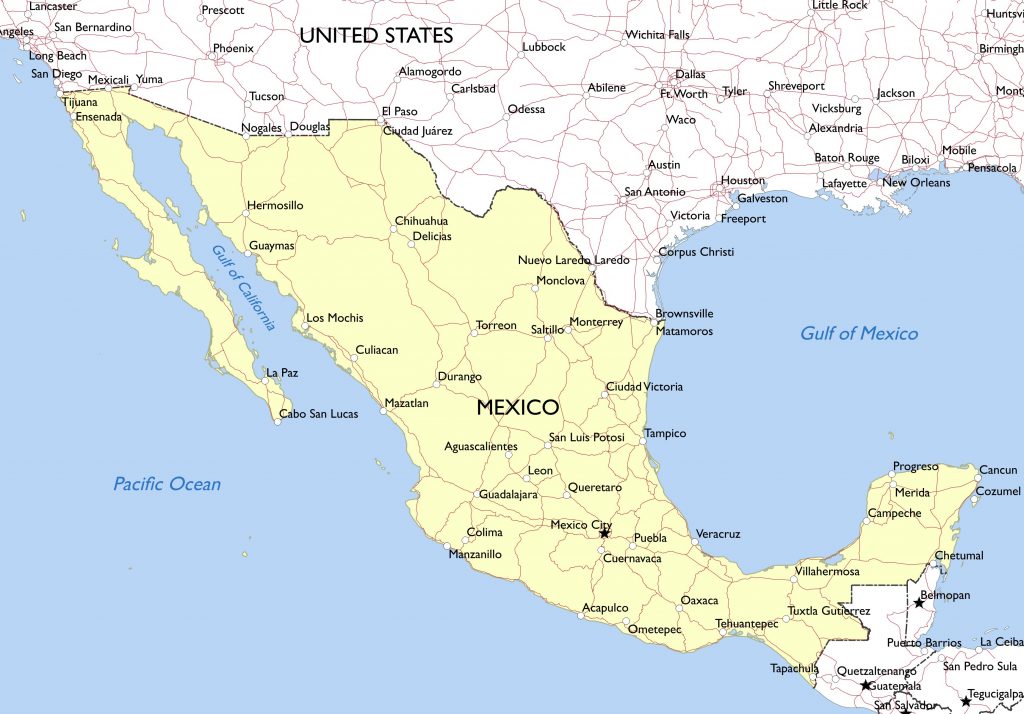
Culinary history: The indigenous people of the area we now call Mexico, had a basic diet of corn, beans, squash, and chilies. This diet provided complex carbohydrates from the corn, minerals from the squash and vegetarian protein from the beans. In the more tropical areas, mangoes, papaya, guava, avocados, and pads of the nopal cactus were consumed. Animal protein came from deer, turkey, rabbits, squirrels, and other small creatures, however, these were generally only eaten by those of high social ranking.
The Spanish arrived in 1519 and brought with them cows, sheep, pigs, horses, oxen, and chicken. While many of the spices, lemons, watermelons, chickpeas, and spinach plants took to the Mexican climate, attempts at growing olives and grapes were unsuccessful. The Spaniards substituted olive oil with pork fat, and wine with aguagardiente, a brew made from sugarcane. A new dish was also established that used both European and local ingredients, mole poblano was an early combination of the two culture’s cuisines, it is made from toasted chilies, cloves, cinnamon, peppercorn, coriander, sesame seeds, chocolate, and turkey or chicken broth cooked into a smooth sauce.
FOODS THAT ORIGINATED IN MEXICO AND CENTRAL AMERICA:
Agave, Allspice, Amaranth, Avocado, Chia seed, Chili pepper, Chocolate, Jicama, Corn (Maize), Lima beans, Papaya, Peanut, Dragon fruit, Squash, Tobacco, Tomatoes, Tomatillo, Vanilla
Tools used in the preparation of Mexican cuisine
Cooking tools used prior to the arrival of the Spanish and still used today include:
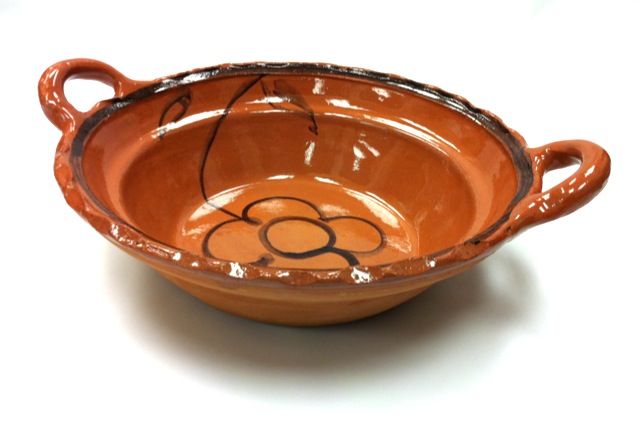
Cazuela – are glazed clay cooking dishes that can be used in the oven, stove top, or grill. They’re come in many shapes and sizes, but are most often shallow and round. Cazuelas retain heat long periods of time, so food continues to cook, even after it has been removed from the heat
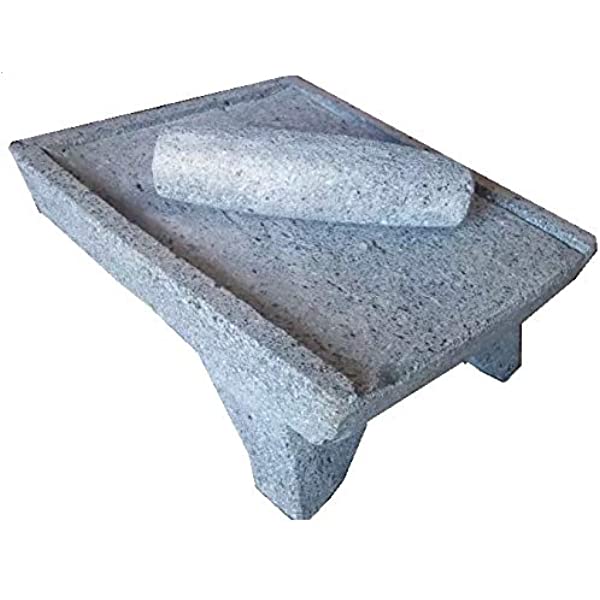
Metate – three-legged curved grinding stone which uses horizontal grinding motion rather than vertical crushing. Archaeologically, Manos and metates were used to process items such as wild seeds and nuts, later, they were used to process cultivated maize

Mano – a smooth hand-held stone used to grind on a Metate or Molcajete. Archaeologically, Manos and metates were used to process items such as wild seeds and nuts, later, they were used to process cultivated maize
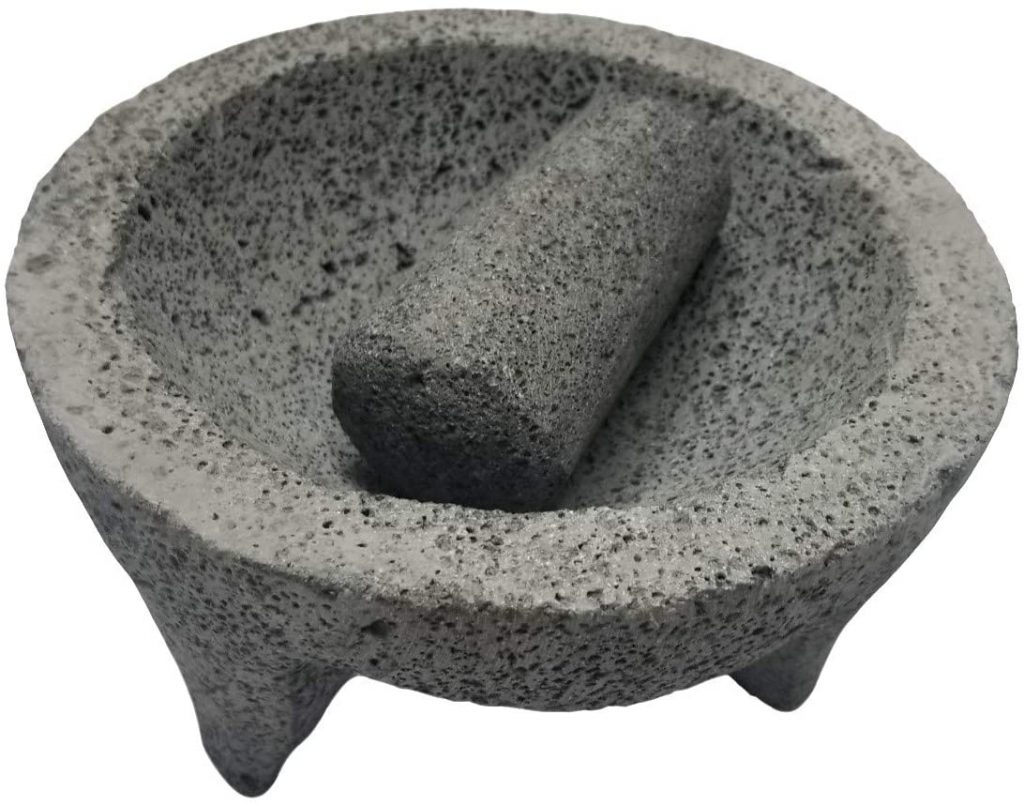
Molcajete – three-legged stone mortar for vertical crushing
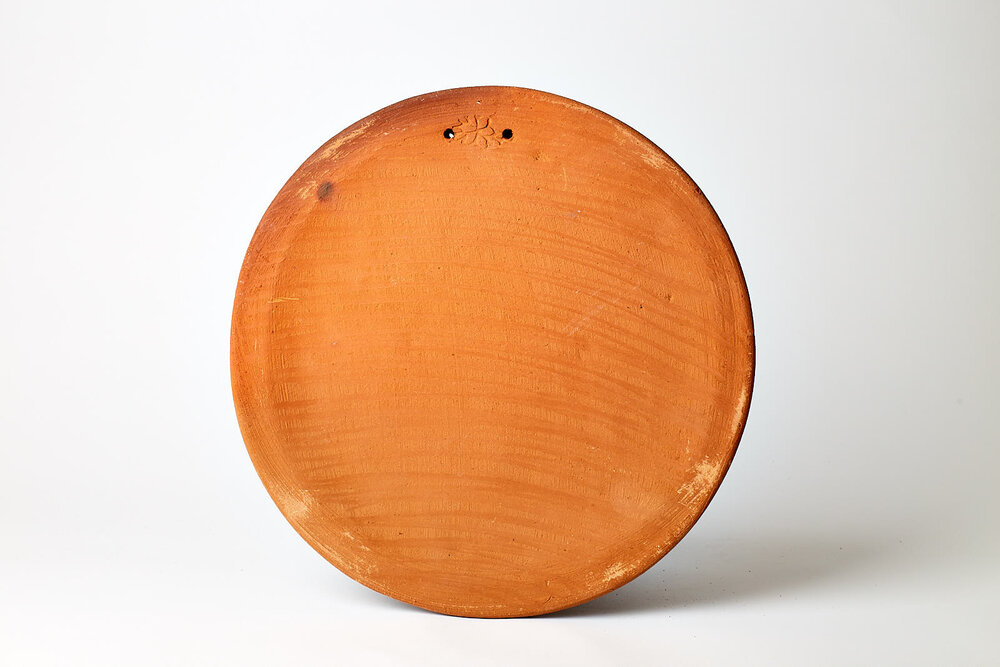
Comal – clay griddle mostly used in South and Central America and in Mexico to make tortillas
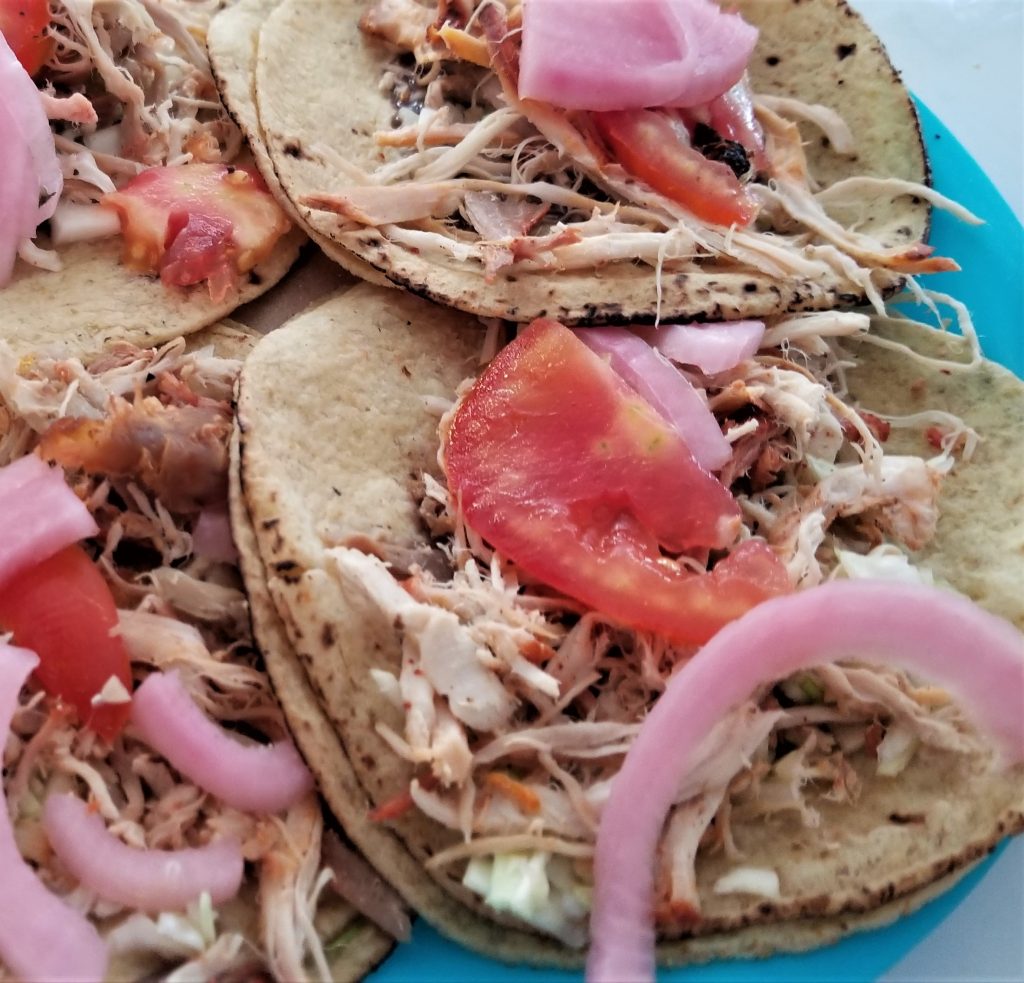
Food from one of the may stalls in the Mercado Lucas de Galvez Market in Merida, Mexico.
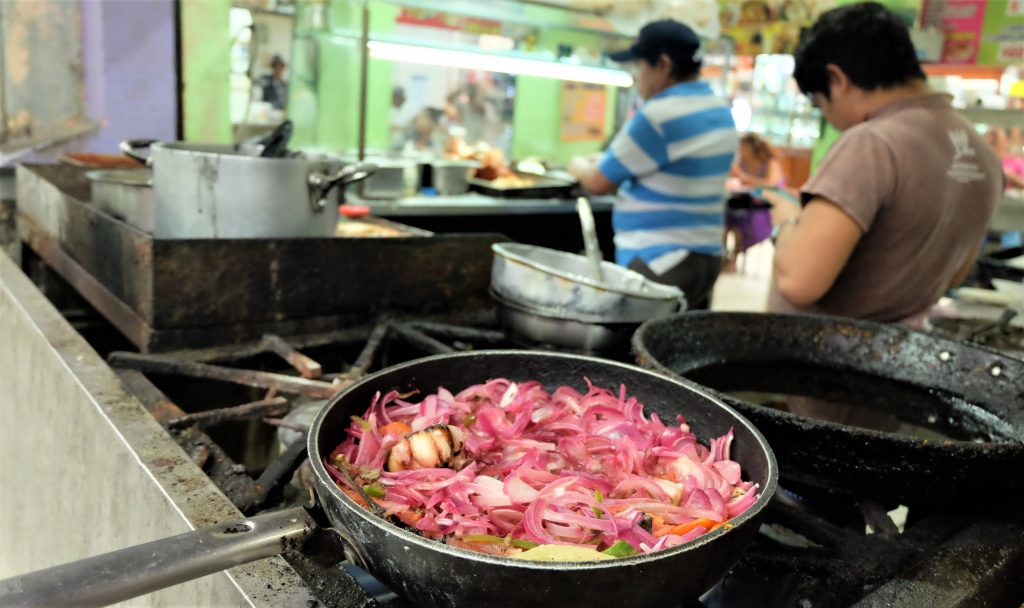
5 essential ingredients in Mexican cuisine
Corn, the main ingredient in tortillas, were traditionally made by curing maize in lime water, grinding the maize, kneading it into a dough, rolling the dough into flat circles, and then cooking it on a very hot Comal (griddle).
Chile peppers are used abundantly in Mexican cuisine. There are over 150 varieties available across the country and are carefully selected to add heat, sweetness, fruitiness, smokiness or earthy flavours.
Tomatoes originated in Mesoamerica (currently central Mexico through Belize, Guatemala, El Salvador, Honduras, Nicaragua, and northern Costa Rica) and were eaten prior to the arrival of the Spanish. Later, Christopher Columbus took the fruit to Europe, where it spread to other parts of the world.
Avocados are very nutritious, they are high in good fat and protein for a fruit. Mesoamericans (currently central Mexico through Belize, Guatemala, El Salvador, Honduras, Nicaragua, and northern Costa Rica) had a diet relatively low in fat, and eating avocados became a vital element for good health.
Nopales is the Spanish name for the edible pads of the Prickly Pear Cactus. It has a mild flavour and can be eaten raw or cooked, it is used in soups, stews and salads. It has a crunchy texture and is soft, but a little sticky, like okra.
Preparation, Table set up, Serving order, and Etiquette
Preparation: All store bought tortillas require heating to finish them off. Wrap a stack of five or fewer in foil and put it into a pre-heated 350° oven for 15-20 minutes, or until heated through. Or place the tortillas in a dry hot skillet over for 30 seconds per side. Then serve covered with a clean, damp, cloth to keep warm.
Table set up: Mexican roadside restaurants often serve the salsa in multiple small dishes and baskets of tortillas when you sit down. However, the salsa is kept on the table during the main course as they can also be used as condiments.
There should be fresh lime cut up into wedges available on the table for people to squeeze on their different dishes.
Serving order: (1) Soup, (2) Appetizer (salsas with tortilla chips), (3) Mains/sides (taco, tamale with or without mole, refried beans, corn on the cob), (4) Dessert at the end of the meal, but drinking throughout.
Etiquette: You can use your hands to eat the finger foods, like tortilla chips and tacos but use utensils to eat everything else. The knife should be held in the right hand and the fork in the left, as the Mexicans do not switch knives and forks. When the meal is finished, the knife and fork should be laid parallel to each other and laid across the right side of the plate .
(3) step 3 – pick your dishes
Since I’m not a chef, I’ve scoured the internet and found some of the best recipes for you to cook. The ones I chose are not too difficult, authentic, and tasty. Cook safely and enjoy!
Pick one or more tacos
A taco is a dish consisting of a small hand-sized corn or sometimes wheat tortilla topped with a filling
- Tacos de pescado – Fish grilled or fried, with lettuce and served with salsa and mayonnaise on a corn tortilla.
- Carne asada – Beef marinated in a citrus based sauce, then grilled and served with salsa on a corn tortilla
- Carnitas – Pork slow cooked and served with salsa on a corn tortilla
Pick one or more tamales
A tamale is a made of masa (dough) and sometimes stuffing, which is steamed in a corn husk or banana leaf.
- Cheese tamale – Masa dough steamed in a corn husk with queso fresco
- Beef tamale –Masa dough steamed in a corn husk with barbacoa style shredded beef
- Chicken tamale – Masa dough steamed in a corn husk with slow roasted shredded chicken
Pick a mole for your tamale
Mole is a marinade and sauce used in Mexican cuisine. Use the mole as a sauce on the tamales of your choice.
- Poblano – Red mole, a complex sauce comprised of a multitude of ingredients including chocolate, dried peppers, and cinnamon
- Verde – Green mole, this mole is flavoured and coloured from pumpkin seeds, cilantro, tomatillos, and jalapeños.
- Negro – Black mole, the ultimate sweet and spicy combination is the most complex version of the sauce. It relies heavily on chocolate and spices like cloves, cinnamon, and cumin.
Pick one or more salsas
Salsa is a common condiment found in Mexican cuisine. Use the salsa as a topping for your taco or have with oven roasted or deep-fried tortillas.
- Pico de gallo – The most well-known salsa composed of fresh tomatoes, onions, chilis, cilantro and lime.
- Salsa verde –Green sauce, composed of blended tomatillo and green chili pepper salsa.
- Guacamole – Avocado blended with onions, cilantro and lemon juice
Pick one or more of the sides
- Tortilla soup – Chicken broth flavoured with charred tomatoes, garlic, ancho chili and onion, garnished with avocado, fried tortilla strips, lime and queso fresco.
- Refried beans – Mashed pinto bean with onion, garlic, and lard.
- Corn on the cob – Grilled ears of corn then brushed with mayonnaise, rolled in crumbled cotija cheese and sprinkled with chile powder.
Pick one or more non-alcoholic beverages
- Horchata – Rice water flavoured with cinnamon and vanilla
- Atole – A thick drink comprised of water, cinnamon, vanilla, masa (corn hominy), and piloncillo (unrefined cane sugar)
Pick one or more Alcoholic Beverages
- Margarita – An alcoholic beverage composed of tequila, orange liqueur, and lime juice served with salt on the rim of the glass
- Paloma – An alcoholic beverage composed of tequila, lime juice, and grapefruit juice or flavoured soda such as Fresca or Jarritos and served with lime
- Mezcal – A distilled spirit made from the agave plant
Pick one or more desserts
Pick a tortilla recipe
- Flour tortilla –Tortillas made with wheat flour
- Corn tortilla – Tortillas made with corn, this type is recommended
- Required– your favorite store bought tortilla chips
recommended combinations
COMBO 1 – cabo san lucas Special
Corn tortilla, tacos de pescado, cheese tamale, verde mole, pico de gallo, and refried beans, jericalla, with a paloma or horchata beverage
Combo 2 – Mayan mayhem special
Corn tortilla, carne asada taco, chicken tamale, poblano mole, guacamole, tortilla soup, churro, with a paloma or horchata beverage
Combo 3 – merida special
Corn tortilla, carnita taco, beef tamale, poblano mole, salsa verde, corn on the cob, jericalla, and with an atole or paloma beverage, corn tortilla
combo 4 – Gringo special
Flour tortilla, carne asada taco, cheese tamale, verde mole, guacamole, refried beans, churro and shots of mezcal or an atole beverage
Combo 5 – Tijuana special
Corn tortilla, carnita taco, chicken tamale, verde mole, pico de gallo, refried beans, churros, with shots of mezcal or a horchata beverage